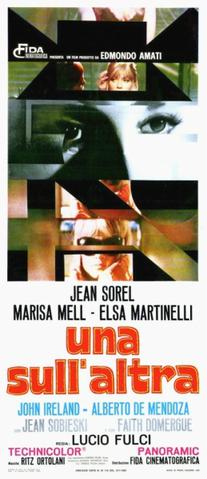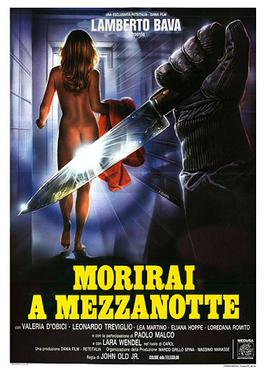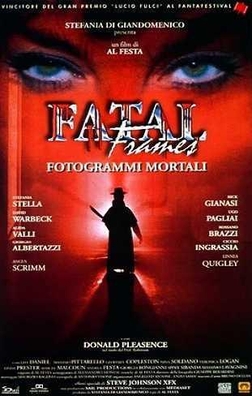Related Research Articles

In Italian cinema, giallo is a genre of murder mystery fiction that often contains slasher, thriller, psychological horror, sexploitation, and, less frequently, supernatural horror elements.

Lamberto Bava is an Italian film director. Born in Rome, Bava began working as an assistant director for his director father Mario Bava. Lamberto co-directed the 1979 television film La Venere d'Ille with his father and in 1980 directed his first solo feature film Macabre.

The Girl Who Knew Too Much is a 1963 Italian giallo film. Directed by Italian filmmaker Mario Bava, the film stars John Saxon as Dr. Marcello Bassi and Letícia Román as Nora Davis. The plot revolves around a young woman named Nora, who travels to Rome and witnesses a murder. The police and Dr. Bassi don't believe her, since a corpse can't be found. Several more murders follow, tied to a decade-long string of killings of victims chosen in alphabetical order.
Claudio Fragasso is a film director and screenwriter. Fragasso first attempted to make art films in the early 1970s, then became a screenwriter in the Italian film industry in the mid-1970s. Fragasso met director Bruno Mattei, which led to a ten-year partnership from 1980 to 1990 during which the two worked together closely on films, with Fragasso's contributions often going uncredited. Fragasso's wife Rossella Drudi was also a screenwriter and collaborated with him on a number of projects. Fragasso would later go on to write and direct his own films in the 1980s, including Monster Dog with rock musician Alice Cooper and After Death. Fragasso directed Troll 2 in 1989, which was later the topic of Best Worst Movie, a documentary film that discussed Troll 2's fandom.
Bruno Mattei was an Italian film director, screenwriter, and editor who directed exploitation films in many genres, including women in prison, nunsploitation, zombie, mondo, cannibal, and Nazisploitation films. Mattei's films often followed popular genre trends of the era. Mattei continued work as a director primarily in the Philippines until his death in 2007, just before he was to enter production on his fifth Zombie film.

Fernando Di Leo was an Italian film director and script writer. He made 17 films as a director and about 50 scripts from 1964 to 1985.
Franco Ferrini is an Italian screenwriter. His works often fall into the genres of horror or thriller. He was one of the interviewees represented in the book Spaghetti Nightmares.

Emanuelle's Revenge is an Italian film directed by Joe D'Amato. It is a remake of the Greek film The Wild Pussycat (1969). Unlike the French Emmanuelle series, to which it refers only in name, Emanuelle's Revenge has been described as being close to a sex-themed giallo, or as a combination of several genres: the rape and revenge film, the splatter film, the erotic film and the thriller. The film was written by Bruno Mattei and D'Amato. Bruno Mattei co-directed the film with D'Amato, but only D'Amato was credited.

Delirium is a 1987 Italian giallo film directed by Lamberto Bava and starring Serena Grandi, David Brandon, George Eastman and Daria Nicolodi. The film is about Gioia, the owner of the adult Pussycat magazine. She is harassed by a killer who sends her photos of her co-workers with her own erotic photography in the background.
Gli incubi di Dario Argento is a TV series created and directed by Dario Argento as part of Giallo Argento, a segment of RAI TV show Giallo by Enzo Tortora.

Umberto Lenzi was an Italian film director whose filmography encompassed a ranges of genres across a prolific career. Born in Massa Marittima, Tuscany, Lenzi studied law before enrolling at the Centro Sperimentale di Cinematografia in Rome. As part of his studies, he wrote and directed the short film Ragazzi di Trastevere, based on Pier Paolo Pasolini's novel Ragazzi di vita. During this time, he worked as a film critic for the Centro's journal Bianco e Nero, and was an avid follower of both European and American films, favouring the work of directors John Ford, Raoul Walsh, and Michael Curtiz.

Cold Eyes of Fear is a 1971 Italian-Spanish thriller film directed by Enzo G. Castellari, starring Fernando Rey.

One on Top of the Other, also known as Perversion Story, is a 1969 giallo film directed by Lucio Fulci. Written by Fulci and Roberto Gianviti, the film stars Jean Sorel, Marisa Mell, Elsa Martinelli, Alberto de Mendoza and John Ireland. The first giallo directed by Fulci, its plot concerns George Dummurrier (Sorel), an unscrupulous San Franciscan doctor who is suspected of orchestrating the death of his asthmatic wife Susan (Mell) as part of an insurance scam, despite her seeming reemergence as Monica Weston, a high-class stripper.

Col cuore in gola is a 1967 giallo film directed by Tinto Brass. It is loosely based on the novel Il sepolcro di carta written by Sergio Donati. The film used storyboards from cartoonist Guido Crepax. It has been released under several titles including Deadly Sweet and I Am What I Am.

The Killer Is on the Phone is a 1972 giallo film directed by Alberto De Martino. It was released in the U.S. in July, 1975. The film is set in Bruges, Belgium, and stars Telly Savalas and Anne Heywood. The story follows an attractive actress who suffers from amnesia and paranoia triggered by a chance encounter with a professional assassin, who in turn begins to follow her with his knife.

Sweets from a Stranger is a 1987 Italian thriller film directed and co-written by Franco Ferrini. The film is about a serial killer targeting sex workers. The women decided to band together to protect themselves, but their efforts are only partially successful as the killer continues their killing spree. As the police investigate, the sex workers group together to try and find some leads on their own.

Formula for a Murder is a 1985 Italian giallo film co-written and directed by Alberto De Martino.

Midnight Killer is a 1986 Italian giallo film starring Valeria D'Obici and Leonardo Treviglio, and directed by Lamberto Bava.
The Seven Magnificent Gladiators is an Italian peplum film directed by Bruno Mattei.

Fatal Frames is a 1996 Italian giallo film directed by Al Festa. It stars his wife, singer Stefania Stella. The film is about the American music video director Alex Ritt who is hired to direct the latest Stefania stelle video in Rome. While there, he witnesses a brutal killing. By the time the police arrive, the body has vanished and no traces of blood are found. When Ritt witnesses a second murder with the same circumstances, he tries to discover the truth.
References
Footnotes
- 1 2 3 4 5 6 7 Howarth 2015, p. 168.
- 1 2 3 4 Lupi & Gazzarrini 2013, p. 80.
- 1 2 3 4 5 6 Curti 2016, p. 195.
- ↑ Lupi, Gordiano; Gazzarrini, Ivo (2013). Bruno Mattei: L'ultimo artigiano (in Italian). Il foglio. ISBN 978-8876064609.
- 1 2 3 4 5 6 Curti 2016, p. 197.
- 1 2 Howarth 2015, p. 169.
- ↑ Curti 2022, p. 392.
- ↑ Curti 2022, p. 9.
Sources
- Curti, Roberto (2016). Diabolika: Supercriminals, Superheroes and the Comic Book Universe in Italian Cinema. Midnight Marquee Press. ISBN 978-1-936168-60-6.
- Curti, Roberto (2022). Italian Giallo in Film and Television. McFarland. ISBN 978-1-4766-8248-8.
- Howarth, Troy (2015). So Deadly, So Perverse. Vol. 2. Midnight Marquee Press. ISBN 978-1936168583.
- Lupi, Gordiano; Gazzarrini, Ivo (2013). Bruno Mattei: L'ultimo artigiano (in Italian). ISBN 9788876064609.